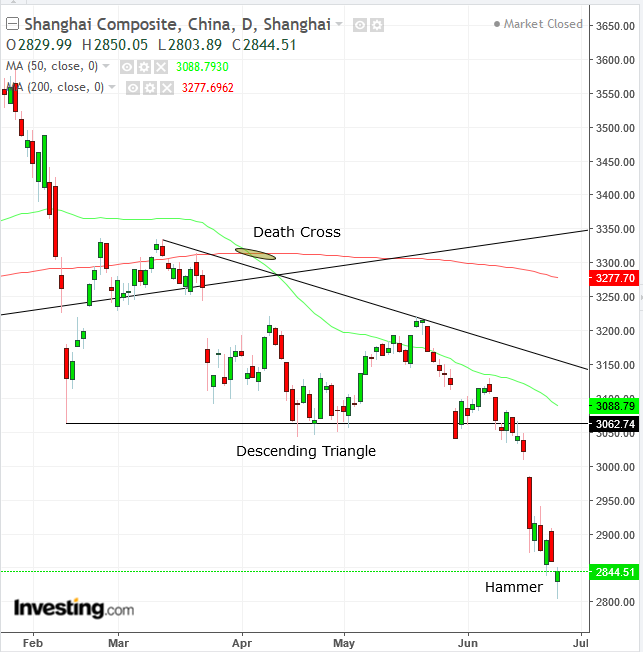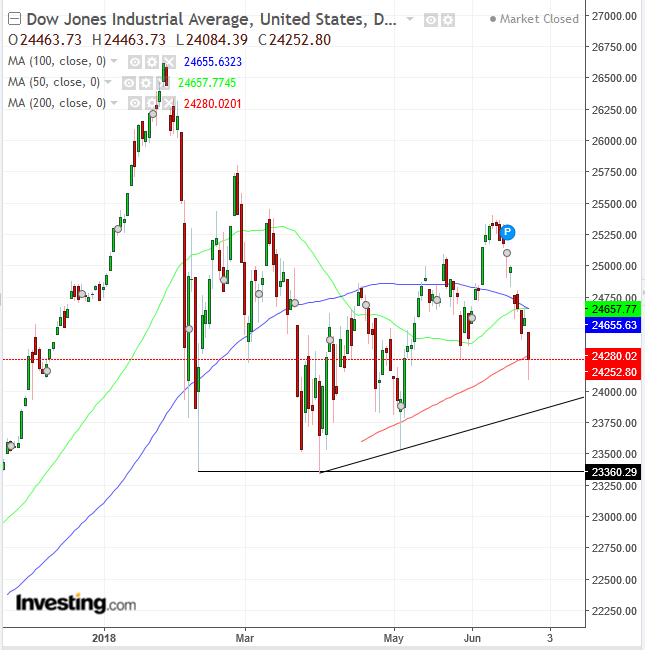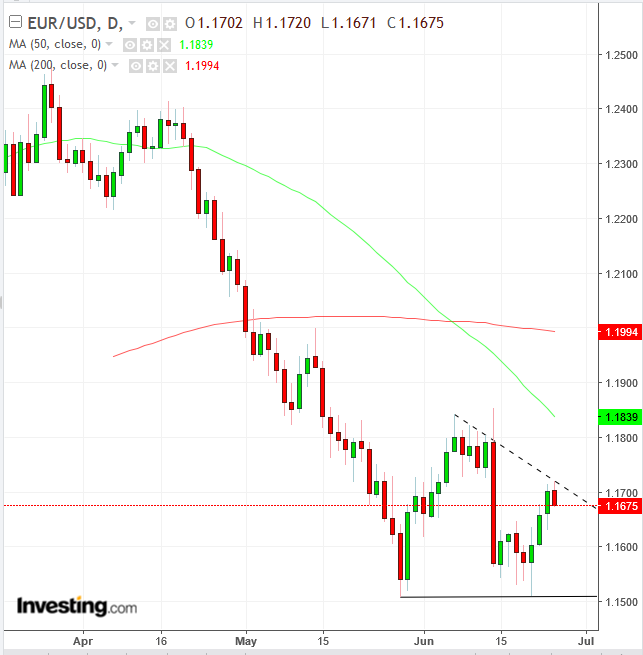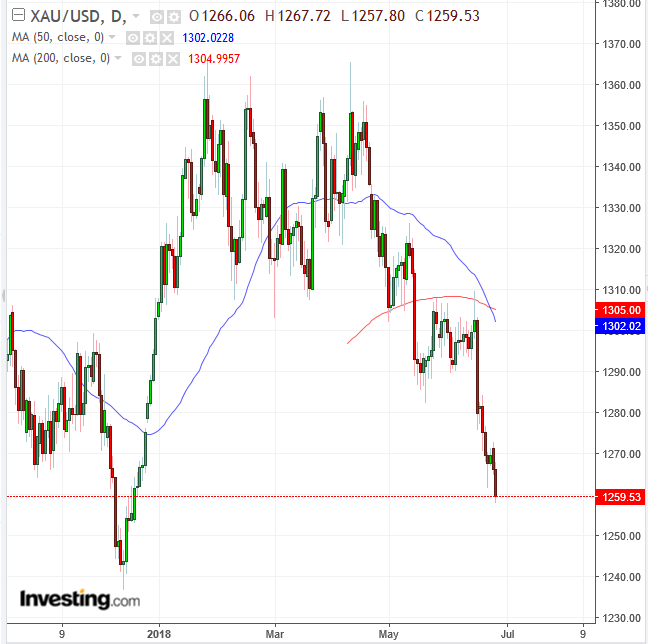-
European shares attempt rebound after yesterday's selloff
-
US futures waver
-
Asian indices trim major losses
-
Shanghai Composite officially slips into bear market territory
-
US majors remain in uptrend despite Dow's fall below 200 DMA and S&P 500's 1.5 percent plunge
- NASDAQ 100 sinks 2.2 percent on looming tech investment squeeze
-
Oil edges higher
-
US dollar strengthens against all major currencies except CAD, weighs on gold
-
German Chancellor Angela Merkel holds private talks with leaders of the other parties in her coalition government on refugee policy and euro-area reforms in Berlin Tuesday.
-
New Zealand and Indonesia monetary policy decisions on Thursday.
-
US personal spending probably increased in May for the third month, economists forecast ahead of Friday's data.
-
China manufacturing and non-manufacturing PMI are due on Saturday. Investors will watching closely for clues on China’s ability to fight a trade war with the world’s biggest economy as well as for clues on global growth general.
-
The STOXX Europe 600 gained 0.2 percent as of 8:01 a.m. London time.
-
Futures on the S&P 500 climbed 0.2 percent.
-
The MSCI All-Country World Index climbed 0.1 percent.
-
The MSCI Asia Pacific Index fell less than 0.05 percent to the lowest level in eight months.
-
The U.K.’s FTSE 100 Index gained 0.2 percent.
-
The Dollar Index rose 0.013 percent, the first advance in a week, and is trading at the high of the session.
-
The euro slipped 0.1 percent to $1.1692.
-
The British pound dropped 0.1 percent to $1.3268, the biggest fall in a week.
-
The New Zealand dollar fell 0.4 percent, the largest fall in a week.
-
The South Korean Won gained 0.2 percent to 1,114.80 per dollar, the biggest increase in almost three weeks.
-
The yield on 10-year Treasuries gained one basis point to 2.89 percent.
-
Germany’s 10-year yield climbed two basis points to 0.34 percent, the biggest increase in more than two weeks.
-
Britain’s 10-year yield gained two basis points to 1.294 percent.
-
Brent crude climbed 0.2 percent to $74.91 a barrel.
-
LME copper slipped 0.3 percent to $6,733.00 per metric ton, the lowest level in almost 12 weeks.
-
Gold fell 0.2 percent to $1,263.41 an ounce, the weakest level in about six months.
Key Events
Global trade seems to be on the mend on Tuesday, with European shares climbing back to positive territory and Asian indices trimming down losses after heightened worries over a squeeze on international trade and investment sparked a heavy equity selloff on Monday.
However, US futures for the S&P 500, Dow and NASDAQ 100 remain mixed at the time of writing, signaling that the global rebound may be tested again during the upcoming US session.
Yields on US Treasurys also bounced back after a three-day decline, while oil prices crawled higher after US Energy Secretary Rick Perry called for more energetic measures to tackle the global oil supply shortage.
The STOXX 600 opened 0.15 percent higher and extended the rally to 0.2 percent, led by miners and banks. However, the price is currently drifting.
Earlier this morning, during the Asian session, Japan’s TOPIX managed to turn a 0.9 percent loss into a 0.15 percent advance, but only after confirming, with an extended low, the downtrend from the May high.

China’s Shanghai Composite rebounded impressively, trimming a 1.9 percent selloff down to a more manageable 0.5 percent drop. However, the initial slide—sparked by mounting worries over the country's ability to withstand a fully-fledged trade war with the US—extended a decline from the January high, pushing the index to a 20-percent slump: the official mark of a bear market.
Hong Kong’s Hang Seng also enjoyed a major recovery, turning a 1.6 percent loss into a limited 0.10 decline. Today’s low brought the aggregate decline from the January high to just under 15 percent.
As well, South Korea’s KOSPI managed to turn a 0.75 percent fall into a minor setback of less than 0.05 percent.
Australia's S&P/ASX 200 trimmed 0.8 percent losses down to minus 0.2. The weak performance of the index, which closed in the red for the third straight session, signaled investors had finally succumbed to global risk-off pressures, after they'd been defying the region's downward trend since mid-month.
Global Financial Affairs
The extreme price swings seen across global markets today follow a US equity selloff that saw the Dow Jones Industrial Average close below its 200-day moving average and the S&P 500 tumble 1.4 percent on Monday—though the latter benchmark managed to bounce back from a plunge of over 2 percent.
But the selling was even more pronounced for tech shares: the NASDAQ 100 sank 2.2 percent lower, roiled by the looming prospect of trade restrictions on foreign investments into US technology—a move that could, more broadly, slash demand for tech stocks.
The market theme that continues to cloud investor sentiment is the growing threat that trade tensions between the US and its key global trading partners will end up halting the first synchronized global growth in a decade. Peter Navarro, trade adviser to US President Donald Trump, tried to calm investor nerves late on Monday suggesting that curbs on foreign investments will be less extensive than currently priced in by markets.
However, despite the tentative policy softening signaled by Navarro—who went on to say that the US economy remains "bullish" and that the country's GDP growth is poised to hit 4 percent—investors seem to be repositioning after noting that Trump's verbal threats, which many expected would be nothing more than rhetoric, are, in fact, beginning to translate into tangible trade policy measures.

Despite the recent selloffs, US equities remain in an uptrend. Even the Dow Jones, whose mega cap, multinational companies rely more heavily on exports for growth and thus tend to suffer widespread selling in times of trade jitters, is still well above its uptrend line and 3.75 percent above its April lows, underscoring good levels of demand.
In other news, WTI crude climbed back above the 50 DMA and Brent flirted with the $75 key level on Perry's comments. Technically, however, WTI and Brent prices are in consolidation mode for the third and sixth day respectively, as traders try to make up their minds about the outlook for the price of oil.

The dollar is strengthening against all major currencies, though it's flat against the loonie. The euro is potentially developing a descending triangle. Note that its bottom is right on top of the 1.1500 round-psychological level, demonstrating the struggle between bulls and bears at this level.

The price of gold has fallen below $1,260, reaching the lowest level since December 15, 2017, as the 50 DMA (blue) crossed below the 200 DMA (red), executing the ominous Death Cross.
Up Ahead
Market Moves
Stocks
Currencies
Bonds
Commodities
